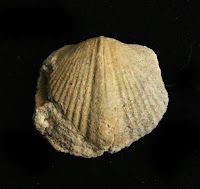Discovering My First Fossil Site
 My grandfather’s ancestral home is in a small mountain town
on the western border of Virginia, surrounded by pastures and forest. My
nonagenarian grandmother still lives there in the warmer months. My brother and
I used to spend hours exploring their 20-acre “back yard,” visiting with the
cows and admiring everything that lived there.
My grandfather’s ancestral home is in a small mountain town
on the western border of Virginia, surrounded by pastures and forest. My
nonagenarian grandmother still lives there in the warmer months. My brother and
I used to spend hours exploring their 20-acre “back yard,” visiting with the
cows and admiring everything that lived there.
But not the rocks. Dull, gray, pitted sandstone is exposed
all over the hillside. It crumbles when rubbed, so no one bothers to build with
it, beyond piling rough stones. My grandparents knew of nothing special about
them. They were good to climb on, or to hold up a shed, but not much else –
until one day when we accidentally broke some.
 |
| A piece of Sandstone that I brought home from my grandmothers house. |
Somewhere around the time I was in middle school, my father
had a notion to cook a roast over an open pit of coals. We built a fire ring in
the woods out of whatever loose stones were handy. It turned out not to be the
best choice. The rocks were saturated
from a recent bout of rain. After a couple hours of expanding in the heat, we
starting hearing loud popping. The rocks were cracking and even
exploding! No one got hurt and the roast was delicious, so we didn’t think much
of it, until we saw the inside of the rocks. Inside the dull, gray crust were
orange, yellow and white centers – and they were pitted with shell impressions.
Fossils!
 Up to that point,
I’d only ever seen fossils in museums or as occasional gravel when we traveled. Here they were right under my feet, and all over the hill. That’s
what those pock marks were, eroded impressions of the shells. My brother and I
were so excited that we spent the rest of the trip throwing rocks down the
hillside onto boulders to smash them open and see what was inside. I still have
some of them today.
Up to that point,
I’d only ever seen fossils in museums or as occasional gravel when we traveled. Here they were right under my feet, and all over the hill. That’s
what those pock marks were, eroded impressions of the shells. My brother and I
were so excited that we spent the rest of the trip throwing rocks down the
hillside onto boulders to smash them open and see what was inside. I still have
some of them today.
Unfortunately, that
was the last time we went smashing open rocks in those woods together. As we
got older, the expectation became that we should stick around with the adults
in the house, especially the grandparents that could no longer get up the hill
as easily.
However, one of
those rocks I brought home ages ago (and subsequently stabilized so it wasn’t
crumbing in the attic) was unbroken. It has some very worn brachiopod
impressions on top and has been waiting for decades to reveal its contents,
when I had the right tools to do it carefully. This morning, I finally cracked
it open and I was not disappointed! Brachiopods on top of brachiopods are
spread across layers of sand and the exposed surface is a wonderful 3D collage.

Epilogue: I spent
the next couple hours pouring through my ever-growing personal library to see
what I could find out about them. Just
finding that tiny town on the geological survey map proved challenging, but in
the end I got some details. The house is sitting on top of a section of the
Middle-Devonian Ridgeley Sandstone Formation, which follows the length of the
valley in a narrow band horizontally, and 100 feet deep. It is known to USGS for
abundant fossils, especially Spiriferid brachiopods. Somewhere out there in my grandmother's back yard, 300 miles away, more sea life is calling to me to be discovered.





Comments
Post a Comment